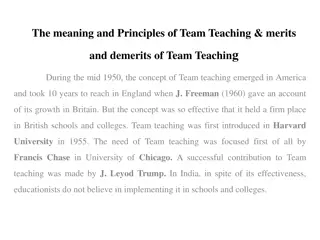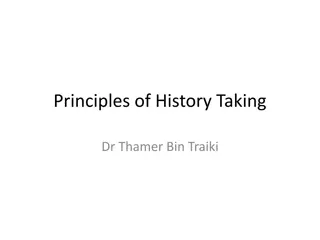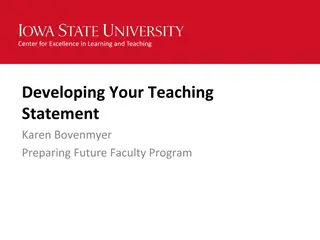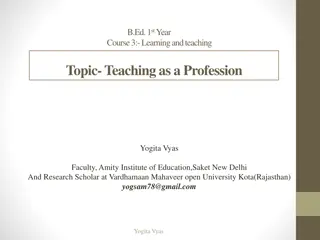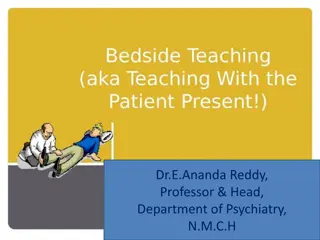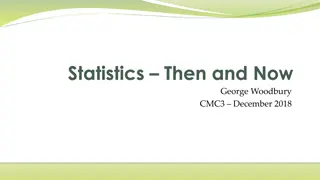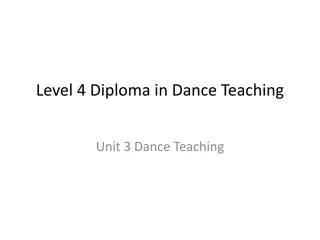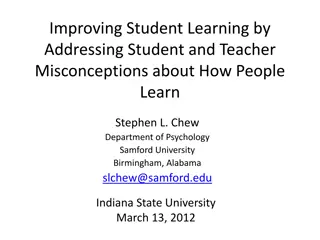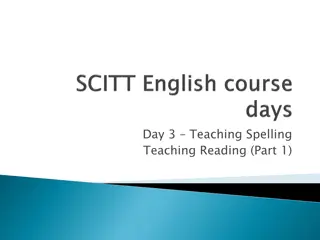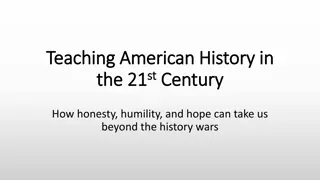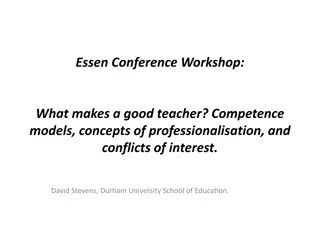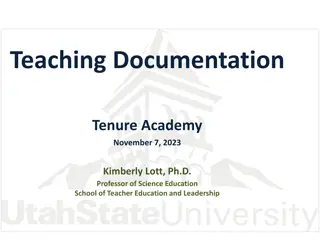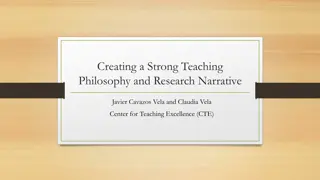Exploring Challenges and Opportunities in Teaching History
Dive into the challenges and opportunities faced in teaching history, focusing on Paper 4 of the U.Mandarin curriculum. Discover how to balance depth and breadth, manage teaching time effectively, and encourage independent study skills. Uncover the complexities of ideological issues and learn ways to make history relevant. Explore the rich historical and cultural heritage of contemporary China, challenging Euro-centrism and integrating it into a global historical context while remembering key events like the Sino-Japanese War.
Download Presentation

Please find below an Image/Link to download the presentation.
The content on the website is provided AS IS for your information and personal use only. It may not be sold, licensed, or shared on other websites without obtaining consent from the author. Download presentation by click this link. If you encounter any issues during the download, it is possible that the publisher has removed the file from their server.
E N D
Presentation Transcript
Teaching & Assessing Teaching & Assessing History History Pre Pre- -U Mandarin Paper 4 U Mandarin Paper 4 Ashley Hern Manchester Grammar School a.hern@mgs.org
Challenges of teaching Paper 4 History Challenges of teaching Paper 4 History Scope of the curriculum Balancing depth vs. breadth Available teaching time Writing and marking essays Complexity of ideological issues Encouraging independent study skills Making it relevant
But there are also opportunities! But there are also opportunities! Placing contemporary China into a historical context: o South China sea conflict o Chinese/Japanese relations o Understanding contemporary Chinese politics Challenging Euro-centrism - making China part of a global history A gateway into China s rich historical & cultural heritage
Remembering the Sino Remembering the Sino- -Japanese War Japanese War China and Japan are divided by the way they remember World War II In Japan the official position has been to forget, while in China the CCP gains legitimacy from remembering the war s atrocities Rape of Nanjing (1937) & the Comfort Women both regularly surface as public issues when relations between China and Japan are strained Xi s look of distaste in 2014 handshake with Shinzo Abe reflect the importance of anti-Japanese feeling tolerated and encouraged by the CCP in China https://www.youtube.com/watch?v=tnFQmh1Xya8
Where do I start? Where do I start? The syllabus begins with the Xi an incident of 1936 and the creation of the Second United Front but how did we get there? The syllabus requires an overview of the developments that led to Xi an various potential starting points: oChina s difficult 19th century? o 4th May movement o The Northern Expedition and the end of the First United Front 1926 27 o The Long March 1934 35 Seeing this as an opportunity for independent learning (using In Our Time (Radio 4)
Pre Pre- -U History Syllabus Breakdown U History Syllabus Breakdown The Sino-Japanese War 1937 1945 The Second United Front The GMD s strategy & conduct of the war The CCP s strategy & conduct of the war The international context especially the role of the USA Key exam questions: What was more significant in China s victory over Japan: internal developments or external factors? Who emerged stronger from the Sino-Japanese War the GMD or the CCP? Key debate (see Rana Mitter) Did Chiang s mistakes lose him the war? How important was the role of the USA? Were the CCP the real anti-Japanese resistance, rather than the GMD?
Rana Rana Mitter Mitter Book Club! Book Club!
Pre Pre- -U History Syllabus Breakdown U History Syllabus Breakdown Mao s theoretical developments in the Yan an period The key elements of Mao Zedong Thought Two Revolutions theory The Mass Line Rectification & thought control Role of art & literature in society The relationship with the USSR Key exam questions: How important were the policies and ideas developed in the Yan anyears in the CCP s success? How far were Mao s ideas put into practice during the early years of the PRC? Key debate To what extent did the Yan an period represent liberation or a new form of social control? How significant was the use of intimidation & the development of the Cult of Personality in shaping the CCP s policies? Were they a means to seize power or a betrayal of the original movement? Understanding Maostalgia in modern China (http://www.bbc.co.uk/news/av/world-asia- pacific-13987651/china-s-red-tourism-makes-revolution-fun)
Understanding Mao Zedong Thought Understanding Mao Zedong Thought
Pre Pre- -U History Syllabus Breakdown U History Syllabus Breakdown The Civil War 1945 1949 (usually examined in the context of 1937 45) The end of the Second United Front The GMD s weaknesses & their conduct of the war The CCP s strengths and strategy esp. support of the peasantry The international context: how did the USSR & the USA determine the outcome? Key exam questions: Was it GMD mistakes or the CCP s strengths that led to the victory of the CCP in 1949? What was more significant: internal developments or external factors? Key debate Did Chiang s mistakes lose him the war? How far did the CCP win the Civil War by default? How important was the attitude of the USA in allowing the CCP victory?
Pre Pre- -U History Syllabus Breakdown U History Syllabus Breakdown The Establishment of the People s Republic The new political and administrative structures of the PRC The effects of the Korean War Role of the USSR Land Reform The First Five Year Plan Education Mass mobilisation projects Key exam questions: How far did the CCP succeed in changing China between 1949 and 1956? How far did Mao put the ideals of the Yan an years into practice? What role did the USSR play in the PRC? Key debate How far were the 1950s a golden age in China? How far did Mao act in his own interest rather than the CCP s or China s?
1949 1949 1956: A Golden Age for the PRC? 1956: A Golden Age for the PRC?
Resources Resources - - textbooks textbooks
Websites Websites Alpha History an excellent resource http://alphahistory.com/chineserevolution/ Asia for Educators a useful background resource http://afe.easia.columbia.edu/ Podcast Series: Modern China https://www.history.org.uk/student/categories/495/module/337 4/podcast-series-modern-china
Techniques for independent learning Techniques for independent learning Guided note-taking Using learning grids Reading articles & multiple-choice tests Student presentations Class debates
Essay writing Essay writing What makes a good essay? Answers the question that is asked, not the question the student wishes was asked Each paragraph s focus is analysis rather than description Analysis is supported by precisely recalled examples There is a coherent argument which shows prior thought and planning: integrative argument An introduction which highlights the key issues A conclusion which brings the threads of the essay together
Assessing essays Assessing essays - - Content Content 23 25 Excellent Excellent ability to organise material in relation to the question. Comprehensive response with an extensive number of relevant points targeting the terms of the question with precision. Displays detailed knowledge and sustained analysis. 19 22 Very good A thoughtful and well-argued response to the question. Includes a large number of relevant points, well illustrated. Displays thorough knowledge, good understanding and analysis of the material. 15 18 Good A well-argued response to the question. Includes a good number of relevant points, most of which are developed and illustrated. Some limitations of insight, but a coherent approach. 11 14 Satisfactory A mainly relevant response to the question. Shows fair knowledge and understanding of the material. Includes a fair number of relevant points, not always linked and/or developed. 6 10 Weak An uneven OR basic response to the question. Shows some knowledge and understanding of the material. Includes some relevant points, but development and illustration are limited. Contains padding AND/OR has some obvious omissions OR is largely narrative/description. 1 5 Poor Little attempt to answer the question. Only elementary knowledge and understanding of the material. Makes very few relevant points and even these are largely undeveloped and unsubstantiated OR a response which makes hardly any attempt to address the terms of the question but which displays a basic general knowledge of the material. 0 No rewardable content.
Assessing essays Assessing essays - - structure structure 5 Very good A well-structured and coherent piece of writing, with ideas and arguments clearly linked throughout. All paragraphs well-constructed. Includes a comprehensive introduction and conclusion. 4 Good A clear structure, with logical presentation of ideas. Most paragraphs well constructed. Includes an adequate introduction and conclusion. 3 Satisfactory Some success in organising material and ideas into a structured piece of writing. A reasonable attempt to paragraph but weakness in introduction and conclusion. 2 Weak Some attempt to organise material and ideas into a structured piece of writing. Many single-sentence paragraphs or no attempt at paragraphing. Organisation of ideas not always logical. 1 Poor No attempt to organise material and ideas into a structured piece of writing. Incoherent. Ideas introduced in no apparent order. 0 No rewardable structure.




